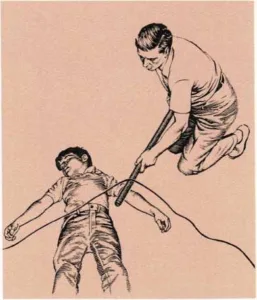Electric Shock
Electric shock is usually much easier to prevent than to treat. It
is very dangerous and can kill or seriously injure anyone.
If your child suffers electric shock, remember that while seconds count,
do not be careless of your own safety. If you find the child unable to
let go of an electric wire, keep calm. Do not touch either the wire or
the child with your bare hands while electricity is still flowing. Pull
the main switch if it is near, or jerk the plug from the socket. If you
cannot turn the electricity off, you will have to move the wire off the
child or the child off the wire. Use anything dry that does not conduct
electricity—boards, branches, wooden poles, folds of cloth or
newspaper, or rubber or heavy cloth gloves. And be sure that you are
standing on a dry surface.
As soon as the child is free, start giving artificial respiration if
breathing has stopped. (See CPR.) If possible have another person call
the paramedics (usually 911).
If you are alone, restore breathing before calling for help. If an
electric spark has caused a burn, treat it later.
A child suffers electric shock usually because an adult has forgotten
how curious and investigative a child can be, or because the adult does
not realize how little a child knows of danger or caution. To a child,
an electric outlet is a fascinating hole in the wall, just right for
poking with a stray
Freeing a child from a live wire

To get a live wire off your child, stand or kneel in a dry place and
move the wire with a broomstick, or with any other object that does
not conduct electricity.
bobby pin. To a child, an appliance cord is for pulling—a child
doesn’t know that it may be faulty. To a child, it is quite possible to
find a favorite television character by poking into the rear of the
television set.
Make your home safe, keep an eye on your child, and let the child
understand that in dealing with dangers your “No” means “Positively no!”
Even the crawler learns to stay away from outlets if you repeatedly pick
the child up, say a firm “No,” move the child to another spot, and offer
a toy. For added safety, buy special plugs that cover the electric
outlets, [m.g.]
See also Accidents; Burns; CPR

